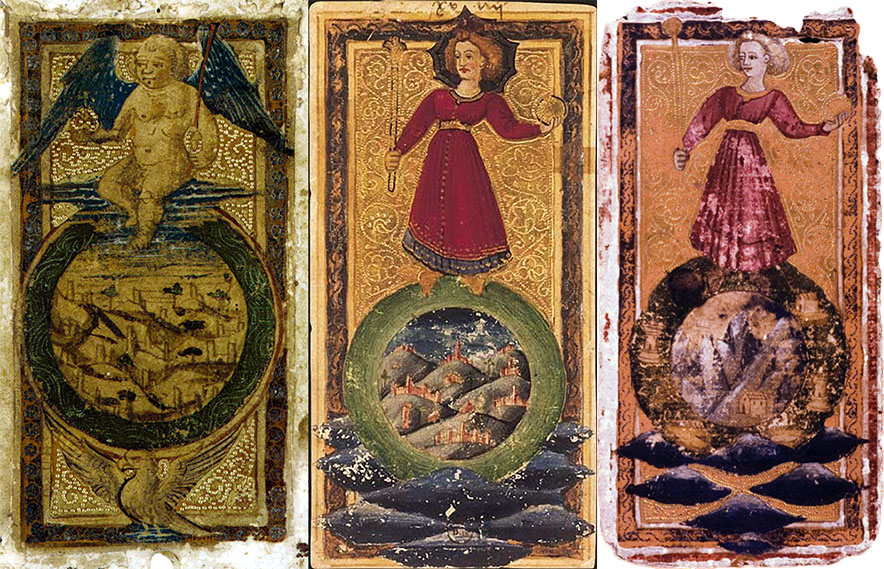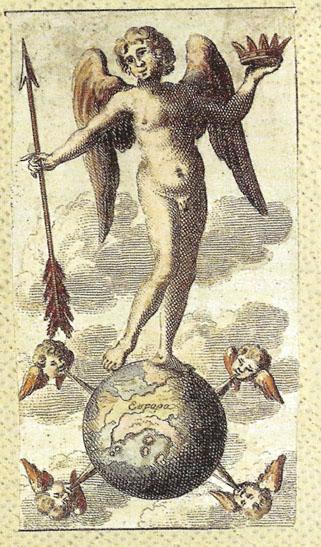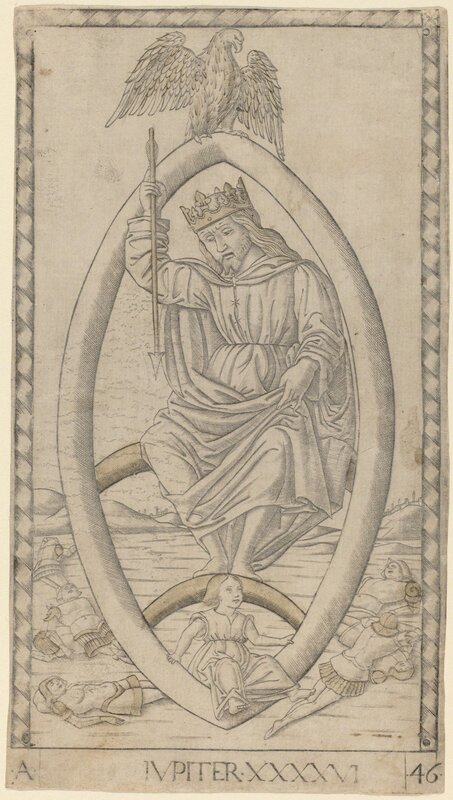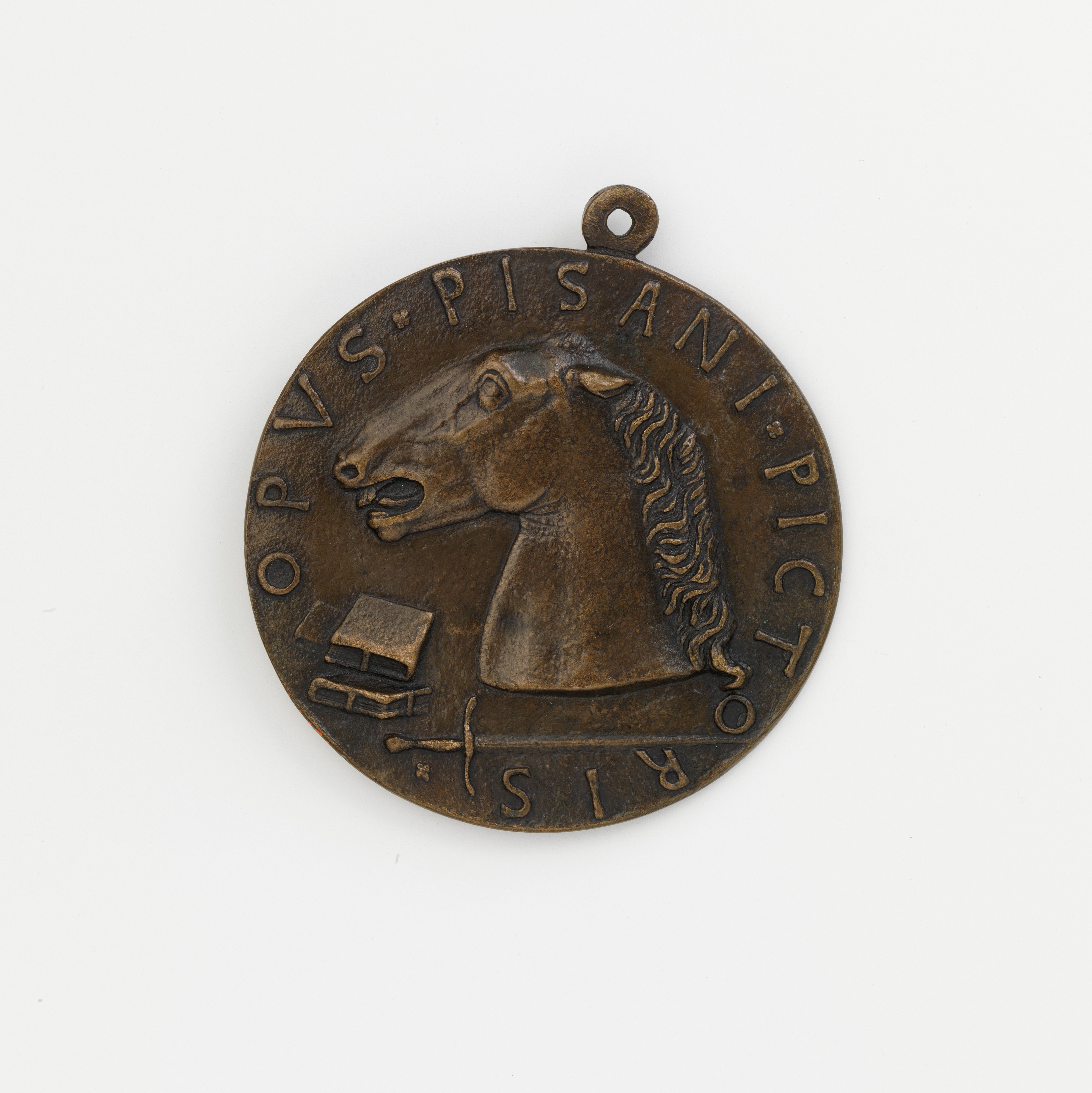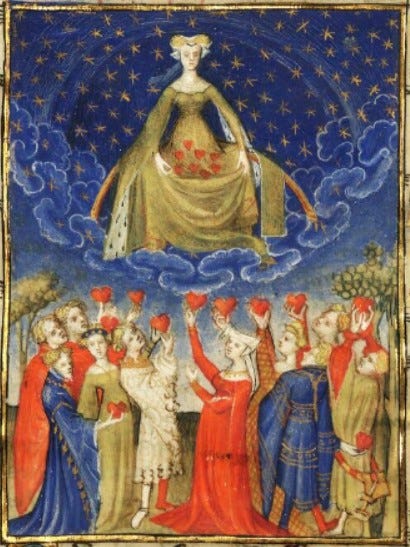mikeh wrote: 29 Jan 2024, 12:21
My reason for bringing up this card - as well as other cards showing people on top holding symbols of domination in both hands - is to say that we need not suppose a familiarity with a tradition of Petrarch illustrations now lost, going back to the time of the Cary-Yale, to find precedents for Robertet's image of Eternity holding a shaft-like thing in one hand and a crown or other symbol of domination in the other.
Well, this is one reason why I said that an important part of my argument will have to be a discussion of the evolution of the World card, demonstrating that all later cards are likely to be descended from something like the VdM World card.
But the big problem with your argument here is that you are ignoring the simple and indisputable fact that the tarot image that bears the closest resemblance to Robertet's Eternity image is the World card in the earliest tarot deck known to us, the VdM deck from the early 1440s—exactly the period to which the accompanying Latin verses can be reliably dated.
Rather than accepting the obvious implication that Robertet's image probably dates from that period too, and that there was therefore probably some close relationship between it and the tarot decks of the early 1440s, you instead embark on a long and convoluted attempt to gather evidence for the far less plausible proposition that the Robertet image was not created until several decades later, and was created at that time on the basis of tarot cards that bear far less resemblance to it than that early World card does.
Why would you engage in such seemingly bizarre and pointless intellectual effort?
Two likely reasons present themselves.
The most obvious one is that you are deeply wedded to your own prior interpretation of the VdM World card as Fame and are extremely unwilling to have to discard that interpretation, because of the extensive theoretical construct that you have built around it.
However, I think there is also another reason, which is worth exploring at length, because it constitutes a fundamental problem in the approach that you and many other tarot people take to the interpretation of historical tarot imagery. It is manifest in this remarkable statement that you made at the end of your second-last post here:
The Robertet image could have been pre-1450, but if so it is strange that there is no trace of the astrolabe feature until decades later (on cassoni), and not on the figure's belt.
"No trace of the astrolabe feature"... and yet, in a
much earlier post in this thread, I called your attention to the following:
[The Robertet Time figure] has a large object hanging from his belt in about the same position as the similarly-sized pouch of the BnF and Bolognese Old Man figures.
I think it's reasonably obvious that this statement of mine was intended to imply that those pouches are very much a "trace of the astrolabe feature". Yet your discussion completely ignores this possibility. Maybe you simply forgot what I wrote; it was several months ago, admittedly. But I doubt that this is the only reason that this slipped your mind. Based on everything you have written on this forum and elsewhere, it appears that you, like most tarot people, are simply very disinclined to perceive these kinds of connections between images, or to take them very seriously when they are pointed out to you.
Like most tarot people, you always seem to want to believe that every artist had an absolutely perfect understanding of what they were doing when they created one of these images, and that it is therefore extremely unlikely for a timepiece to be transformed accidentally into a pouch. Yet that is manifestly not the case: such accidental transformations did indeed occur when images created by one artist were copied by another, and they occurred often.
There is a useful parallel here with the copying of manuscript text. Scribal copyists regularly made errors and alterations when copying a text from an earlier manuscript. The copyists of images (whether in manuscripts, on playing-cards, or any other media where images were frequently copied) were prone to making exactly the same kind of errors and alterations as the scribes.
This is because these copyists rarely had an entirely perfect understanding of the earlier text or image, and the imperfections of their understanding took the same essential forms, whether they were copying words or pictures. These forms can be mainly categorized as follows:
1.
Misinterpretation: The copyist misread or misunderstood something in the original text or image, consequently rendering it as a different word or different pictorial detail. Examples include the
Ecce/Esse at the start of the last line of the Death quatrain, or the famous transformation of the hourglass into a lantern on the Time card of early tarot decks.
2.
Accidental omission: The copyist overlooked or forgot some detail in the original, resulting in a missing word in the text, or a missing detail in the image. An example is the missing single-syllable word immediately after
Ecce/Esse in the last line of the Death quatrain.
3.
Attempted improvement: The copyist changed some word or detail because they believed that the change would improve the text or image. In many cases, this was not a copying error as such, but deliberate embellishment, or a correction of a genuine mistake in the earlier text or image (such as the addition of
sed after
Ecce/Esse in the last line of the Death quatrain in some of the French copies). But not infrequently, the copying scribe or artist was
miscorrecting something in the original text or image—something that they mistakenly believed to be an error, but which had actually been intentional.
All of these types of alteration result in what could be termed "imperfect copies", imperfect in the specific sense that they result in a text or image that deviates from the intention of the creator of the earlier text or image that is being copied.
An awareness of this phenomenon, and a willingness to acknowledge occurrences of it, are essential to any understanding of the history of something like tarot cards, yet it is something that most tarot people largely neglect. Instead, they tend to focus almost exclusively on attempting to explain the "meaning" of each detail in each image, considered largely independently of any image that preceded it in the chain of copying, and certainly with no regard to possible imperfections in the artist's understanding of that previous image.
Now, it is all very well to seek to explain why the artist may have thought it appropriate to put a lantern in the Old Man image, for instance. That can be an interesting and useful line of inquiry in itself. But if you are attempting to reconstruct the complete history of the image, you need to be capable of acknowledging that, regardless of what it might have meant or symbolized to the artist who put it there, that lantern is also ultimately an imperfect copy of an earlier hourglass.
The same applies to copied text: sure, it's helpful to explain that the Modena copyist wrote
Ecce at the start of that line because it seemed to make sense there. But it's much more important to a reconstruction of the history of the text to realize that it could well have been a misreading of
Esse, and that this word (whether
Esse or
Ecce) must also have been followed by some single-syllable word that was accidentally omitted from the Modena text. And it is similarly important to realize that the insertion of
sed in that position in some French manuscripts was primarily an attempt to remedy that omission, and was not added just because the scribe liked the resulting wording.
Coming back to Robertet's Time image and its "astrolabe feature": the reason I think that the pouches of the BnF Old Man and the Bolognese Old Man are derived from that "astrolabe feature" is precisely because, as you noted, "I do not know of any Triumph of Time other than Robertet and after that shows anybody wearing a portable astrolabe on their belt - or a clock, sundial, or zodiac disc in that place." Not only that: other than on tarot cards, I have seen no other 15th century Time image that shows the figure with
anything at all hanging from his belt, with the sole exception of a
printed edition from 1494 showing a small ring of beads there. Yet there are no less than four early tarot cards that show Time with something obviously hanging from his belt: there is the pouch on the two cards already mentioned, and there is also the large white ribbon affixed to the belt of Time on the Catania card and the Charles V card.
My hypothesis is that both the pouch and the large white ribbon are "imperfect copies" of exactly the same earlier object, namely a version of the "astrolabe feature" of the Robertet Time image. Both the pouch and the ribbon are essentially inexplicable in themselves: neither symbolize Time in any way, and neither appear on any other known images of Time, or even on any other Old Man cards in tarot decks. It is therefore very likely that they derive from some alteration of an earlier object.
It is my belief that the "astrolabe feature" of the Robertet Time image is itself likewise an imperfect copy of an earlier object. This is because it must surely have been intended to be a timepiece of some kind, yet it does not exactly resemble any type of timekeeping device. It is not likely to have been an astrolabe, because astrolabes normally have eccentric rings, not purely concentric ones like those of this object, and in any case astrolabes were not primarily timepieces: that was just one of their many possible uses, and not the most prominent. It doesn't look like a portable sundial either, because it lacks the element required to cast the shadow, and it is much larger than portable sundials usually were at this time. Portable sundials in the late Middle Ages and Renaissance were often quite small items, made in two identically-sized halves that folded up together like a wallet (
image here). I am actually inclined to think that the other, smaller object on the belt of the Robertet Time figure could have originally been a portable sundial, before imperfect copying transformed it into the small pouch we see in the surviving image (and like the ribbon and pouch on the tarot cards, the presence of that little pouch is otherwise inexplicable, as it adds nothing to the allegorical representation). But the larger, circular object is unlikely to have ever been a portable sundial.
So what was it? The most likely explanation is that it was originally a nocturnal. (If you want to google for images and information about these devices, I recommend using the Latin, French, Italian, or German names: nocturlabium, nocturlabe, notturlabio, Sternuhr). Nocturnals looked more or less exactly like the object on the belt of Robertet's Time, except that it omits the pointer component: a long bar radiating out from the center of the disk, often slightly wider at its far end and tapering to a narrower width at the center of the disk. What I suspect happened when this image made its way onto tarot cards is that one or more artists omitted the pointer and transformed the disk into a pouch, but others appear to have omitted the disk and retained the tapered pointer instead, transforming it into the large white ribbon that we see on the Catania and Charles V image. This hypothesis neatly explains the origin of all three images—the pouch, the ribbon, and the Robertet disk—as all being derived from a single original image of a timepiece. Moreover, if that disk was originally a nocturnal, and the smaller object on the belt was originally a portable sundial, then the original Time image would have shown the figure wearing a matching pair of timepieces, one for the day and one for the night, which works beautifully in the context of this allegory.
Incidentally, the BnF Old Man and the Bolognese Old Man both provide us with another example of imperfect copying, in addition to the pouch at their belt. In each one, Time's hourglass has also been transformed, but in different ways: in the first case into a lantern and in the second case into the pillar behind the figure's back.
I also mentioned another possible example of imperfect copying in my
last post in this thread, when I suggested that the palm and crown of Robertet's Eternity could have originally been a winged trumpet and crown. You appear to have overlooked that post of mine entirely, as you normally reply to everything, but you have made no reply to any part of that one at all (an alternative possibility is that you ignored it deliberately, because you did not wish to admit that Hurst's interpretation of the VdM World could be correct, but I hope I am wrong to even imagine such a possibility). You again ignored my discussion of the palm and crown in your last post here, where you wrote "In the Robertet, however, the palm leaf, substituting for the arrow, represents Eternity's victory, and the crown, it seems to me, the reward of those who triumph with her (and not her own triumph, because she has her own crown)."
